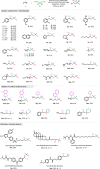Modular access to alkylfluorides via radical decarboxylative-desulfonylative gem-difunctionalization
- PMID: 40394025
- PMCID: PMC12092675
- DOI: 10.1038/s41467-025-60011-0
Modular access to alkylfluorides via radical decarboxylative-desulfonylative gem-difunctionalization
Abstract
Fluorine-containing compounds hold pivotal importance in life sciences. Recent decades have witnessed significant research efforts toward developing practical fluorination methods. Radical-mediated decarboxylative fluorination has proven to be a robust approach for incorporating diverse monofluoroalkyl groups. Here we show a radical-mediated modular synthesis of alkyl fluorides through a decarboxylative-desulfonylative gem-difunctionalization under mild photochemical conditions. The multi-component reaction proceeds in a controlled sequence of radical decarboxylation and heteroaryl migration, governed by radical polarity and kinetic effects, resulting in a wide range of valuable alkyl fluorides. Two C-C bonds and one C-F bond are concurrently formed throughout the process. Both styrenes and aliphatic alkenes serve as suitable substrates for this transformation. Furthermore, this method can be applied to the incorporation of a monofluoroalkyl moiety into complex alkene molecules at a late stage.
© 2025. The Author(s).
Conflict of interest statement
Competing interests: The authors declare no competing interests.
Figures




Similar articles
-
Efficient Docking-Migration Strategy for Selective Radical Difluoromethylation of Alkenes.Angew Chem Int Ed Engl. 2018 Dec 21;57(52):17156-17160. doi: 10.1002/anie.201811346. Epub 2018 Nov 27. Angew Chem Int Ed Engl. 2018. PMID: 30397991
-
Radical-Mediated Remote Functional Group Migration.Acc Chem Res. 2020 Aug 18;53(8):1620-1636. doi: 10.1021/acs.accounts.0c00306. Epub 2020 Jul 24. Acc Chem Res. 2020. PMID: 32706572
-
Merging Fluorine Incorporation and Functional Group Migration.Chem Rec. 2023 Sep;23(9):e202200221. doi: 10.1002/tcr.202200221. Epub 2022 Nov 11. Chem Rec. 2023. PMID: 36367274 Review.
-
Recent Advances in First-Row Transition Metal-Catalyzed Reductive Coupling Reactions for π-Bond Functionalization and C-Glycosylation.Acc Chem Res. 2023 Nov 21;56(22):3292-3312. doi: 10.1021/acs.accounts.3c00531. Epub 2023 Nov 2. Acc Chem Res. 2023. PMID: 37917928
-
Transition-Metal-Catalyzed Monofluoroalkylation: Strategies for the Synthesis of Alkyl Fluorides by C-C Bond Formation.Angew Chem Int Ed Engl. 2022 Feb 7;61(7):e202112251. doi: 10.1002/anie.202112251. Epub 2021 Dec 9. Angew Chem Int Ed Engl. 2022. PMID: 34658121 Review.
References
-
- Dolbier, W. R. Structure, reactivity, and chemistry of fluoroalkyl radicals. Chem. Rev.96, 1557–1584 (1996). - PubMed
-
- Müller, K., Faeh, C. & Diederich, F. Fluorine in pharmaceuticals: looking beyond intuition. Science317, 1881–1886 (2007). - PubMed
-
- Purser, S., Moore, P. R., Swallow, S. & Gouverneur, V. Fluorine in medicinal chemistry. Chem. Soc. Rev.37, 320–330 (2008). - PubMed
-
- Meanwell, N. A. Synopsis of some recent tactical application of bioisosteres in drug design. J. Med. Chem.54, 2529–2591 (2011). - PubMed
-
- Wang, J. et al. Fluorine in pharmaceutical industry: fluorine-containing drugs introduced to the market in the last decade. Chem. Rev.114, 2432–2506 (2014). - PubMed
Grants and funding
LinkOut - more resources
Full Text Sources
Research Materials

